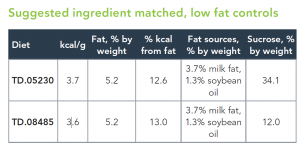Harlan TD.88137 高脂饲料 Adjusted Kcal Diet (42% from fat)
Harlan Teklad动物饲料
Harlan代理
欢迎新老客户访问Harlan官网或者咨询中国代理商上海金畔生物获取更多详细资料。
Harlan TD.88137 高脂饲料 Adjusted Kcal Diet (42% from fat)
A staple of atherosclerosis research
More than 25 years ago, our nutritionists collaborated with researchers at Rockefeller University to develop a diet with features of a ‘Western Diet’ to characterize and enhance atherosclerosis development in their newly generated Apoe deficient mouse model. With over 200 unique users worldwide, TD.88137 continues to be fed to genetically modified cardiovascular models to accelerate and enhance hypercholesterolemia and plaque formation.
Formula g/Kg
Casein 195.0
DL-Methionine 3.0
Sucrose 341.46
Corn Starch 150.0
Andydrous Milkfat 210.0
Cholesterol 1.5
Cellulose 50.0
Mineral Mix, AIN-76 (170915) 35.0
Calcium Carbonate 4.0
Vitamin Mix, Teklad (40060) 10.0
Ethoxyquin 0.04
Critical dietary features of TD.88137 related to atherosclerosis development include:
++Cholesterol (0.2% total cholesterol)
++Total fat (21% by weight; 42% kcal from fat)
++High in saturated fatty acids (>60% of total fatty acids)
++High sucrose (34% by weight)
Typical fatty acid profile of TD.88137
Typical fatty acid analysis,% of diet1 Mean SD
Total 20.7 1.5
Saturated fat 12.8 0.8
Monounsaturated fat 5.6 0.5
Polyunsaturated fat 1.0 0.2
Unknown2 1.3 0.3
Selected nutrient information1
Key points from the literature
TD.88137 has been used to accelerate atherosclerosis development in Apoe and Ldlr deficient models:
++In Apoe deficient mice, plasma cholesterol triples to >1500 mg/dL within three weeks (1, 2). Foam cell and lesion development occurs within 6-10 weeks
(2-4). Fibrous plaque formation is observed at 15 weeks with the development of fibrous caps after 20 weeks (2).
++Ldlr deficient mice fed for two weeks increase plasma cholesterol to >800 mg/dL and triglyceride to >300 mg/dL (5). After six weeks of feeding, hyperglycemia, hyperinsulinemia and dyslipidemia develop with small foam cell lesions in the aortic
arch (6, 7).
With over 420 citations, uses of TD.88137 continue to evolve and include atherosclerosis, obesity, non-alcoholic steatohepatitis (NASH), osteoporosis,
hypertension and metabolic syndrome. Contact us for a more extensive reference list.
Control diet options for TD.88137
Natural ingredient diets
++Also referred to as standard diets or chow
++Diets differ in the source and level of nutrients as well as the presence of non-nutritive factors (such as phytates or phytoestrogens) compared
to TD.88137
++Limits inferences to differences in dietary pattern versus a specific dietary component
Ingredient matched, low fat diets
++Controls for the type of ingredients, non-nutritive components and the source and level of specific nutrients
++Suggested ingredient matched, low fat dietary controls for TD.88137 listed below; data sheets can be found on our website at envigo.com
Suggested ingredient matched, low fat controls

References 参考文献
1. Plump, A.S., et al., Severe hypercholesterolemia and atherosclerosis in
apolipoprotein E-deficient mice created by homologous recombination in
ES cells. Cell, 1992. 71(2): p. 343-53.
2. Nakashima, Y., et al., Apoe-deficient mice develop lesions of all phases of
atherosclerosis throughout the arterial tree. Arterioscler Thromb, 1994.
14(1): p. 133-40.
3. Febbraio, M., et al., Targeted disruption of the class B scavenger receptor
CD36 protects against atherosclerotic lesion development in mice.
J Clin Invest, 2000. 105(8): p. 1049-56.
4. Nakashima, Y., et al., Upregulation of VCAM-1 and ICAM-1 at atherosclerosis-prone
sites on the endothelium in the Apoe-deficient mouse. Arterioscler Thromb
Vasc Biol, 1998. 18(5): p. 842-51.
5. Towler, D.A., et al., Diet-induced diabetes activates an osteogenic gene regulatory
program in the aortas of low density lipoprotein receptor-deficient mice.
J Biol Chem, 1998. 273(46): p. 30427-34.
6. Tsuchiya, K., et al., FoxOs integrate pleiotropic actions of insulin in vascular
endothelium to protect mice from atherosclerosis. Cell Metab, 2012. 15(3): p. 372-81.
7. Huszar, D., et al., Increased LDL cholesterol and atherosclerosis in LDL receptordeficient
mice with attenuated expression of scavenger receptor B1. Arterioscler
Thromb Vasc Biol, 2000. 20(4): p. 1068-73.
8. Yang, B., et al., Changes of skeletal muscle adiponectin content in diet-induced
insulin resistant rats. Biochem Biophys Res Commun, 2006. 341(1): p. 209-17.
9. Schafer, K., et al., Leptin promotes vascular remodeling and neointimal growth
in mice. Arterioscler Thromb Vasc Biol, 2004. 24(1): p. 112-7.
10. Lijnen, H.R., et al., Nutritionally induced obesity is attenuated in transgenic mice
overexpressing plasminogen activator inhibitor-1. Arterioscler Thromb Vasc
Biol, 2003. 23(1): p. 78-84.
11. Maquoi, E., et al., Modulation of adipose tissue expression of murine matrix
metalloproteinases and their tissue inhibitors with obesity. Diabetes, 2002.
51(4): p. 1093-101.
12. VanSaun MN, et al. 2009. High fat diet induced hepatic steatosis establishes a
permissive microenvironment for colorectal metastases and promotes primary
dysplasia in a murine model. Am J Pathol 175:355-64.
13. Dixon LJ, et al. 2013. Caspase-1 as a central regulator of high fat diet-induced
non-alcoholic steatohepatitis. PLoS One 8:e56100.
上海金畔生物科技有限公司
日本关东化学 日本柴田科学 Harlan动物饲料 Amresco中国代理商
